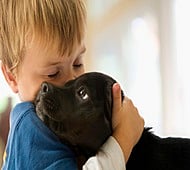London: Dogs have evolved facial muscles over thousands of years allowing them to make the cute 'puppy eyes' to better communicate with humans, a study claims. The study, published in the journal Proceedings of the National Academy of Sciences (PNAS), is the first detailed analysis comparing the anatomy and behaviour of dogs and wolves. Researchers from University of Portsmouth in the UK found that the facial musculature of both species was similar, except above the eyes.
Dogs have a small muscle, which allows them to intensely raise their inner eyebrow, which wolves do not. The team suggests that the inner eyebrow raising movement triggers a nurturing response in humans because it makes the dogs' eyes appear larger, more infant like and also resembles a movement humans produce when they are sad.
"The evidence is compelling that dogs developed a muscle to raise the inner eyebrow after they were domesticated from wolves," said Juliane Kaminski, from University of Portsmouth. "We also studied dogs' and wolves' behaviour, and when exposed to a human for two minutes, dogs raised their inner eyebrows more and at higher intensities than wolves," said Kaminski.
"The findings suggest that expressive eyebrows in dogs may be a result of humans unconscious preferences that influenced selection during domestication," she said. "When dogs make the movement, it seems to elicit a strong desire in humans to look after them. This would give dogs, that move their eyebrows more, a selection advantage over others and reinforce the 'puppy dog eyes' trait for future generations," she added.
Kaminski's previous research showed dogs moved their eyebrows significantly more when humans were looking at them compared to when they were not looking at them. "The movement is significant in the human-dog bond because it might elicit a caring response from humans but also might create the illusion of human-like communication," Kaminski said.
"To determine whether this eyebrow movement is a result of evolution, we compared the facial anatomy and behaviour of these two species and found the muscle that allows for the eyebrow raise in dogs was, in wolves, a scant, irregular cluster of fibres," she said.
The raised inner eyebrow movement in dogs is driven by a muscle which doesn't consistently exist in their closest living relative, the wolf. This is a striking difference for species separated only 33,000 years ago. The remarkably fast facial muscular changes can be directly linked to dogs' enhanced social interaction with humans.








